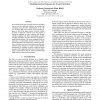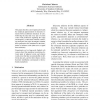AAAI
2012
12 years 5 months ago
2012
Event extraction systems typically locate the role fillers for an event by analyzing sentences in isolation and identifying each role filler independently of the others. We argu...
ACL
2012
12 years 5 months ago
2012
This paper describes a novel approach towards the empirical approximation of discourse relations between different utterances in texts. Following the idea that every pair of event...
ACL
2012
12 years 5 months ago
2012
The Chinese comma signals the boundary of discourse units and also anchors discourse relations between adjacent text spans. In this work, we propose a discourse structureoriented ...
ACL
2012
12 years 5 months ago
2012
We describe a discourse annotation scheme for Chinese and report on the preliminary results. Our scheme, inspired by the Penn Discourse TreeBank (PDTB), adopts the lexically groun...
KCAP
2011
ACM
13 years 6 months ago
2011
ACM
Some discourse structures such as enumerative structures have typographical, punctuational and laying out characteristics which (1) make them easily identifiable and (2) convey hi...
BMCBI
2011
13 years 6 months ago
2011
Background: Identification of discourse relations, such as causal and contrastive relations, between situations mentioned in text is an important task for biomedical text-mining. ...
ACL
2009
14 years 1 months ago
2009
Articles in the Penn TreeBank were identified as being reviews, summaries, letters to the editor, news reportage, corrections, wit and short verse, or quarterly profit reports. Al...
SIGDIAL
2010
14 years 1 months ago
2010
Two of the main corpora available for training discourse relation classifiers are the RST Discourse Treebank (RST-DT) and the Penn Discourse Treebank (PDTB), which are both based ...
ACL
1992
14 years 4 months ago
1992
I In this paper we present algorithms for the interpretation and generation of a kind of particularized conversational implicature occurring in certain indirect replies. Our algori...
AAAI
2006
14 years 4 months ago
2006
This paper describes a framework for recognizing contradictions between multiple text sources by relying on three forms of linguistic information: (a) negation; (b) antonymy; and ...








